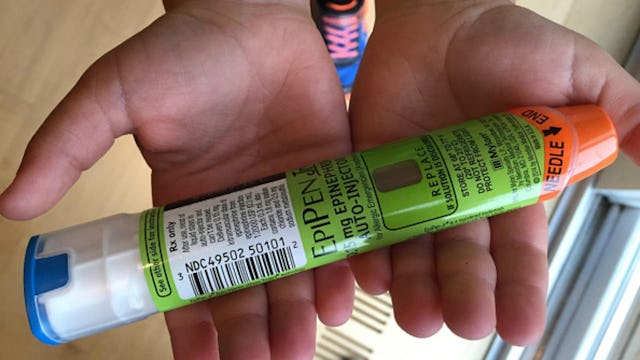Why All Parents Should Know How To Use An EpiPen

My children do not have allergies, but several of their good friends and family members do. Over the years, I have had allergy kids in my care, and I do my very best to keep them safe. I take steps to ensure that I won’t expose them to whatever food or substance they are allergic to – and I even keep parent-approved alternative snacks or desserts on hand for these kiddos.
There have been a few kids who have come over to our house with allergies so severe that they keep an EpiPen on them at all times, and their parents have notified me of this. I always assumed that if they – God forbid – ever needed to use their EpiPen, we would just figure it out. I mean, how hard can it be to use, right?
Well, it occurred to me recently how crappy a plan that is in actuality. Yes, if a child in my care ever were to need to use an EpiPen, I would not hesitate to use it, and I would figure it out as quickly and carefully as I could. But the reality is that we’d all be in a panic, and it makes a whole lot more sense to do a little preparation beforehand should an emergency like that occur.
After all, any child in my care is as precious as my own. And if my child were in need of life-saving medical equipment, I would want anyone who cared for that child to know how to use it.
Thankfully, it turns out that EpiPen usage is pretty straightforward, and there are a lot of great resources out there to help you learn to use one.
Let’s start with the first step, a vital one, actually – knowing when you need to use an EpiPen.
EpiPens are to be used when a child is showing signs of anaphylaxis, a severe, life-threatening allergic reaction. It’s important to note that if you suspect any of the signs of anaphylaxis, it’s better to err on the side of caution and administer the EpiPen. Note, also, that EpiPens (which contain epinephrine) are the first line of defense here, not an alternative like Benadryl.
“Some people hesitate to give the EpiPen because they are unsure if a serious reaction is happening,” Dr. Jalkut, M.D., from Pediatric Healthcare Associates, tells HuffPost. “Many parents ask if they can give Benadryl and wait and see before giving epinephrine.”
Dr. Jalkut adds that “it is imperative that epinephrine be given as soon as possible.” And that administering the EpiPen is meant to stabilize someone to give them time to get to the hospital. “Benadryl is not a substitute for epinephrine,” he says.
So what are the signs of allergic anaphylaxis? According to the Mayo Clinic, signs of anaphylaxis usually occur within minutes of consuming or being exposed to an allergen, and may include:
– Flushed or pale skin, itching, hives
– Itchy throat or tongue, trouble breathing, wheezing
– Low blood pressure
– Weak/rapid pulse
– Nausea, vomiting, or diarrhea
– Feeling lightheaded, dizzy
– Fainting
Sometimes it can take up to a half hour for the symptoms to occur after exposure, but the onset is usually rapid. Dr. Jalkut explains that anaphylaxis often is multi-symptomatic.
“Another clear sign of anaphylaxis is if symptoms involve two systems,” Dr. Jalkut tells HuffPost, “like hives and vomiting, or wheezing and abdominal pain.”
But of course, any of these symptoms should be taken with utmost seriousness, because if not treated soon enough, anaphylaxis can be fatal.
When you feel sure that EpiPen use is in order, the manufacturers of EpiPen explain that the first step is to sit the child upright. You will be administering the EpiPen in their thigh, and you don’t need to remove their clothes to do so – the EpiPen can even go through a pair of jeans.
Here’s how you administer the pen:
1. Take the pen out of the tube (you will be opening a green cap if it’s a child’s dose, a yellow cap for an adult dose).
2. Hold the EpiPen in your hand, making a fist around the tube, with the blue tip pointing up and the orange tip pointing down. The orange end is the one containing the needle.
3. Take off the blue cap, which is the the safety release. Make sure to keep your hand away from orange end, because that is where the needle with be released.
4. Hold the child’s leg firmly in place and press the orange end of the EpiPen into the child’s outer thigh.
5. You will hear a “click” sound, indicating that the needle has been released, though you will not actually see the needle.
6. Hold the EpiPen in place for three full seconds.
7. Remove pen and then immediately call 911.
This last step is important. Don’t call 911 before administering the pen because you don’t want to waste any time. But call afterwards (or rush the child to the ER) because the EpiPen is really supposed to keep the child safe until paramedics can take over. On some occasions you will need to administer the EpiPen more than once if the allergic reaction is not subsiding quickly enough.
Here’s a video that goes through everything for you:
Of course, none of this is meant as medical advice, and you should come up with a plan of care with the parent’s child based on their specific needs. Still, we should all take a few minutes out of our day to watch the video and note the simple steps for correct EpiPen usage.
It truly takes a village to raise a child, and the allergy kids in our communities deserve the most attentive and protective care we can give them. So let’s dive in and do our part.
This article was originally published on